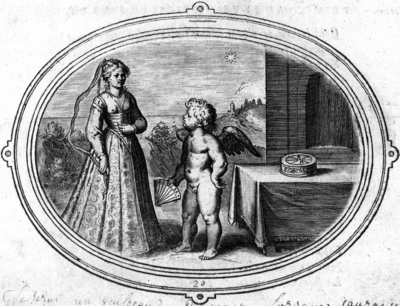Ero navis amoris, habens te astrum lucidum [20]

Translations
 |
Musaeus Grammaticus, Carmen de Herone et Leandro 212.
Ik zal het schip van liefde zijn, met jou al stralende ster. [cf. Cats, Sinne- en minnebeelden 49; Giovio, Dial. p. 80.] |
 |
Musaeus Grammaticus, Carmen de Herone et Leandro 212.
I will be the schip of love, having you as a shining star. [cf. Cats, Sinne- en minnebeelden 49; Giovio, Dial. p. 80.] |
 |
Fate governs people, dear lovers are united (unbelievable!) because the god himself brings them together. He makes a dear
girl-friend lead her lover just like the Great Bear leads a magnet. |
Literature
- Henkel and Schöne, Emblemata
 , col. 1471
, col. 1471
- Porteman about the compass and the Pole Star, taken from Giovio:
Hooft, Emblemata amatoria
 , p. 146
, p. 146
- Praz, Seventeenth-Century Imagery
 , pp. 107-108
, pp. 107-108
- Sebastiàn, Lectura crítica
 , p. 22
, p. 22
Sources and parallels
- The compass: Hugo, Pia desideria (ed. Arwaker)
 , bk/embl. 3/4
, bk/embl. 3/4 - Also in: Animos nil dirimit. [49] (in: Jacob Cats, Sinne- en minnebeelden (1627))
[Compare
![Compare [compare]](/static/images/compare2.gif) ]
]
-
And in: Een treckt my [3] (in: Pieter Cornelisz. Hooft, Emblemata amatoria (1611))
[Compare
![Compare [compare]](/static/images/compare2.gif) ]
]
-
Porteman 1975, p. 213. Pictura slightly altered in:Curiositas Amoris [77] (in: Ludovicus van Leuven, Amoris divini et humani antipathia (1629))
[Compare
![Compare [compare]](/static/images/compare2.gif) ]
]
-
Same pictura, slightly altered, different motto, same Latin subscriptio:Amor mihi Astrum. [39] (in: anonymous, Emblemata amatoria (1690))
[Compare
![Compare [compare]](/static/images/compare2.gif) ]
]
-
The compass also in:Animos nil dirimit. [49] (in: Jacob Cats, Sinne- en minnebeelden (1627))
[Compare
![Compare [compare]](/static/images/compare2.gif) ]
]
-
The power of love compared with the power of magnetism also in:Animos nil dirimit. [48] (in: Jacob Cats, Proteus (1618))
[Compare
![Compare [compare]](/static/images/compare2.gif) ]
]
References, across this site, to this page:
- Animos nil dirimit. [48] (in: Jacob Cats, Proteus (1618))
- Animos nil dirimit. [49] (in: Jacob Cats, Sinne- en minnebeelden (1627))
- Animos nil dirimit. [49] (in: Jacob Cats, Sinne- en minnebeelden (1627))
- Amor mihi Astrum. [39] (in: anonymous, Emblemata amatoria (1690))
- Een treckt my [3] (in: Pieter Cornelisz. Hooft, Emblemata amatoria (1611))
Iconclass
A cupid, holding a quadrant, faces a woman; a star indicating the North (pole); a compass on the table- stars and constellations (with NAME)
[24D1(POLARIS)]

- compass
[25C21]

- coast
[25H13]

- lover (woman) alone (e.g. longing for the beloved)
[33C2162]

- terrace
[41A351]

- table
[41A711]

- cover for table, etc.
[41A713]

- quadrant, sextant, octant (nautical instruments)
[46C2822]

- Strength, Power; 'Fortezza', 'Fortezza d'Animo e di corpo', 'Fortezza del corpo congiunta con la generosité dell'animo', 'Fortezza
& valore del corpo congiunto con la prudenza & virtù del animo', 'Forza' (Ripa) (+ emblematical representation of concept)
[54A7(+4)]

- (personifications and symbolic representations of) Love; 'Amore (secondo Seneca)' (Ripa) (+ emblematical representation of
concept)
[56F2(+4)]

- proverbs, sayings, etc. (with TEXT)
[86(ERO NAVIS AMORIS, HABENS TE ASTRUM LUCIDUM)]

- other non-aggressive activities of Cupid
[92D156]

![[H O M E : Emblem Project Utrecht]](/static/images/rd-small.gif)


















































































































































